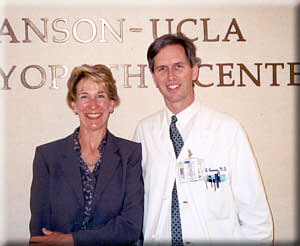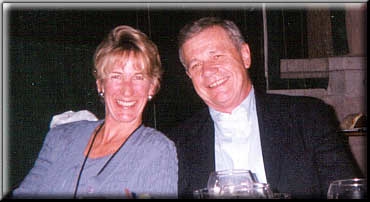The EPP To Eradicate Mesothelioma
Tom Hazen is a 58-year-old senior manager within the medical instruments industry (specializing in dental, ophthalmic and surgical lasers) who was diagnosed with right sided pleural malignant meso-thelioma by doctors in Mission Viejo, California on May 17, 2000. Tom and his wife Sandy reside in San Clemente in a beautiful custom made home within a gated community on the beach. He lives a few blocks away from former President Nixon's fabled "Western White House."
Life on the beach has been good. Tom is a tall slender man with an athletic build who reminds me of a youthful Walter Matthau. He's both charming and easy going -- at the same time, he has a razor sharp wit and an analytical mind that searches for solutions like a moth to light. Sandy, as Tom puts it, "is pure sweetness and light." She exudes good cheer and optimism. She is the kind of person who breaks down barriers. Within a few minutes, your guard comes down and you find yourself revealing personal secrets and exchanging warm hugs.
Six months ago, Tom and Sandy would rise early in the morning and walk along the beach to the San Clemente pier. A few times a week they would play tennis. Tom enjoyed swimming at the community pool. They enjoyed surf fishing and hiking. They knew their neighbors and liked them. Most of all, they enjoyed the hearty and humor-filled company of their two boys, David, age 29, and KT, age 31, who seemed to always be bringing over their friends after a run, ocean swim or triathlon.
Hands-On Parenting
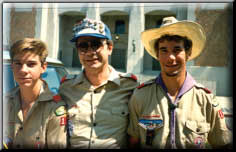
Tom and Sandy's bond with their children rises above any "parent-child" relationship. They play together like kids -- like friends. They genuinely love each other's company -- an idyllic rapport that is the natural result of Tom and Sandy's "hands-on" approach to child rearing. Tom spent several hours every week coaching his boys in track and field, baseball and soccer. In high school David was ranked as one of the top pole vaulters in the nation and later went on to pole vault on the UCLA track team. Tom was the Scoutmaster for a boy scout troop that included KT and David, both of whom earned their Eagle Scout badges. Although Tom has always worked -- he's a self-described "work-a-holic" -- he always managed to find time for his kids, who in turn as adults seem to always have time for their parents.
Tom earned his degree in Mechanical Engineering in 1963. After spending the next seven years working in dirty, dusty industrial plants, including the notorious Kaiser Steel Mill in Fontana, California, Tom realized that he had higher calling. After putting in 60 hour weeks at the Kaiser Steel Mill, at night he went to school at UCLA where he eventually earned his MBA in 1971. For the next 29 years, Tom has been an executive senior manager for various medical device companies -- a far cry from the oppressive heat and swirling dusts of Henry Kaiser's Dark Satanic Mill. Tom left the asbestos-infested mills, but millions of asbestos fibers went with him.
Early Warning Signs: Shortness of Breath and "Puny" Feeling
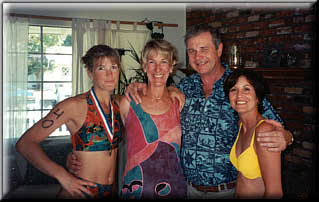
In early April of 2000, Tom and Sandy attended a birthday party for a friend in Mexico. Tom began to feel "puny", a malaise which he attributed to a virus. He stopped playing tennis. He began sleeping more. He and Sandy began to walk more slowly for shorter distances. His breathing became labored. He thought he had pneumonia. Tom had always been robust. He did not even have a family doctor. So he spoke to his next door neighbor, a medical doctor, who prescribed antibiotics.
On the sixth or seventh day after taking the antibiotics, he could no longer climb the stairs to the patio on the roof of their two story house, where Tom had spent many an hour formulating the business plan for a new company he and his partners were starting. Tom, who knows his body like an Indy Driver knows his race car, knew something was seriously amiss. Sandy called her family doctor to set up an appointment for Tom. Tom resisted the temptation to go to the hospital, but his shortness of breath became acute.
Crisis Prompts ER Visit
On May 1, 2000 at 8:30 pm Tom acknowledged that his condition had become critical. He was feeling chronic pressure and pain. His heartbeat became irregular -- a fact which Tom kept secret from his wife in order to spare her the added worry. He and Sandy rushed to the South Coast Medical Hospital in Laguna Beach. On arrival at the hospital he calmly advised the doctor: "I think I have a collapsed lung." The ER doctor first diagnosed arrhythmia. He ordered a chest film which showed a pleural effusion and/or soft tissue mass that was pressing against his chest wall, mediastinum and pericardium. The film also confirmed a partially collapsed lung.
One hour later, the ER doctor drained the pleural effusion, withdrawing 3.5 liters of fluid. A radiologist looked at the film and his differential diagnosis included mesothelioma. Tom was admitted to the hospital. When the ER doctor explained his findings, he did not mention cancer or "mesothelioma." However, Sandy interpreted the findings to raise the possibility of lung cancer. She asked the doctor about "the 'C' word" and the ER doctor said this could not be ruled out without more diagnostic testing.
Doctors asks about Asbestos
On May 2, 2000, Tom had a CT of the chest, which showed extensive diffuse mediastinal swelling with encroachment of the trachea, along with extensive soft tissue density in the pleural cavity. That evening while Tom was in his hospital bed, Dr. Jungwirth explained that Tom had a pleural based tumor and "inflamed lymph nodes." He asked Tom if he had ever worked around asbestos.
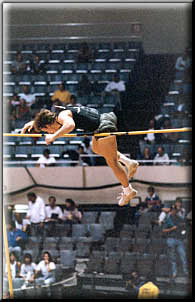
Son David Hazen clearing the bar at the prestigious Sunkist meet. 'We spent hours perfecting David' s mother. tom had never met him before. sandy said later that she felt sorry for dr. jungwirth, who had to deliver this very bad news. this is typical of the hazens:their first concern is always the health and welfare of those around them.
Dr. Jungwirth ordered additional tests to rule out the possibility of a primary site elsewhere in the body. He referred the Hazens to Dr.Chino, a cardio-thoracic surgeon, who he thought would want to take a tissue biopsy and perform a talc pleurodesis to prevent future effusions. The Hazens went home, dazed, but not confused. The tests indicated a cancer of the pleura. With the help of their friends, the Hazens set out to learn more about what they were dealing with and more importantly, how to beat it.
Mesothelioma Suspected
The word that kept coming up in their internet search was "mesothelioma", an asbestos related tumor of the pleura that usually presented with a pleural effusion and shortness of breath. Tom and Sandy poured over the grim survival statistics and prayed that they would dodge this bullet. Sandy had begun marshaling her "prayer warriors" together in an effort to beseech God to spare Tom from this hideous tumor. She asked her friends to "pray like mad." The Hazens hoped for the best but prepared for the worse. They made an appointment that week with their family lawyer to create a living will and trust.
On May 9th, the Hazens met with an oncologist, Dr. Nagasawa. Sandy asked him about mesothelioma. Dr. Nagasawa said mesothelioma was a possibility, but they needed a tissue biopsy. The plan was for Dr. Chino to perform another pleuracentesis, remove a tissue sample through an open lung biopsy, and insufflate the pleural space with talc in order to prevent future effusions. He also arranged to have the specimens assayed in order to determine which types of chemotherapy drugs may provoke a response in vitro.
Dr. Nagasawa was reluctant to definitively diagnose mesothelioma. Tom asked him point blank if indeed he did have mesothelioma, what was the prognosis? Tom's practice in business and life has always been to identify the worse case scenario and then plot a course to carefully avoid it. If he had mesothelioma, he wanted to know the odds, so that he could configure a way to beat them.
Dr. Nagasawa said the tumor appeared to be stage IV because of lymph node involvement. Dr. Nagasawa would not address the question directly. He instead explained that for lung cancer patients the first attack was chemotherapy. If the tumor responded, the median survival was 6 months to 2 years. If no response, the survival was 3-4 months. Dr. Nagasawa ordered more CT scans of the pelvis and stomach, which were negative for a tumor metastasis or primary.
Sandy recalled later her emotional state after meeting with Dr. Nagasawa: "It was like, 'get the shovel,' your husband has three months to live."
Dr. Chino Performs Talc Pleurodesis
On May 11, the Hazens met with Dr. Chino, the surgeon. He explained that he would perform the talc procedure. They did not discuss the option of surgically debulking or extricating the tumor. Without using the words expressly, Dr. Chino's take home message was that the tumor was inoperable -- at least by him. Dr. Chino was respectful and honest, but the news was brutal.
On May 12, Tom was placed under general anesthesia and Dr. Chino performed the pleuracentesis, talc pleurodesis video-guided bronchoscopy and open lung biopsy. The tissue and fluid were submitted to the pathologist. The next day, Dr. Chino advised the Hazens that based on the tumor's appearance and diffuse nature he thought Tom had malignant mesothelioma.
Local Surgeon Recommends Dr. Sugarbaker
Dr. Chino candidly admitted that he did not have the expertise to operate on the tumor and recommended that they contact Dr. David Sugarbaker in Boston, who was world renown for his tri-modal therapy approach to treating mesothelioma patients. Dr. Chino said that the removal of the lung and pleural cavity was a radical procedure that carried a 30% risk that the patient would die on the operating table. Dr. Sugarbaker's mortality numbers were 5%.
To put those numbers in perspective, during his deposition, which was attended by twenty (20) lawyers, Tom testified: "This means that of the 20 lawyers in this room, using a local surgeon six of you would die on the table, but if you were operated on by Dr. Sugarbaker, only one of you would not make it."
On May 17, 2000, the pathologist used immunoperoxidase stains to rule out adenocarcinoma and confirm the diagnosis of malignant mesothelioma. Dr. Nagasawa called that day to inform Tom and Sandy of the diagnosis.
Tom, like all athletes, is very in tune with his body. He knows when he's on, and when he's off. I asked him at his deposition if he could feel the tumor. "Yes. It was pushing against my heart. I could feel it growing. Did you ever see that movie with Sigourney Weaver? Alien? Where the alien bursts through the guy's chest? That's what I felt like, like there was an alien inside me, moving, and I had to get it out." Tom was adamant about going to Boston without further delay to cut the beast out.
Preparations for Dr. Sugarbaker
The Hazens contacted Dr. Sugarbaker 's office and arranged for an appointment in Boston on June 6. Sandy assumed the task of amassing all the records and films and tissue blocks. Additionally, they arranged to complete further tests, including blood work, an MRI and an echocardiogram (ECG). The ECG showed that Tom's heart was strong. The MRI was less optimistic.
Sandy recalled: "We looked at the MRI and it scared us to death. We could see how the tumor was wrapping around the lung and pushing the heart over to the left. It was bending the trachea like a garden hose." On the positive side, the MRI ruled out that the tumor had spread beyond the pleural cavity. Dr. Jungwirth compared the MRI to the CT film from a month prior and noted some growth. The Hazens did not sleep that night.
Sandy's own stress began to build. She and Tom had been married for over 30 years and she had always felt like her flesh was his and vice versa. She had begun to have chest and lung pain. She kept thinking about all those years when Tom worked at Kaiser Steel and she would beat the dust out of his work clothing. She had a chest film taken, which thank goodness was clean. She also noted a numbness and tingly sensation in her left arm. She had an EKG, which was normal. Sandy's symptoms were caused by the stress from knowing that her husband -- her soul mate, best friend and life-line -- was living with a terminal cancer.
The Extra Pleural Pneumonectomy
When Tom and Sandy flew to Boston, they had been warned that Dr. Sugarbaker is very much in demand and has a long waiting list. The typical interval between the initial consult and the operation was several weeks. Tom understood this but did not flinch, as if he enjoyed the challenge of convincing a prestigious doctor to make an exception to the rule. He also knew that "with God, all things are possible." Tom met with Dr. Sugarbaker on a Tuesday and sure enough Dr. Sugarbaker agreed to change his schedule in order to accommodate Tom.
On June 14, 2000, Dr. Sugarbaker removed Tom's lung and the 1-2 inch tumor that completely encased it. He also removed portions of the diaphragm and the pericardium (heart sac). Dr. Sugarbaker used a gore-tex patch to sew the diaphragm back together and to hold the heart muscle in place. Nature abhors a vacuum, and without the patch in place, there is a risk that the heart would collapse into the void left in the right chest cavity. Dr. Sugarbaker advised that he had removed all visible tumor and he did not see any evidence that the tumor had invaded the stomach. He also said, with the conviction of a doctor who has spent the last decade operating on hundreds of mesothelioma patients, "I hate this tumor." Tom thanked Dr. Sugarbaker for "saving my life."
Tom and Sandy understand that the operation was not a cure. Tom acknowledges that "undoubtedly" there are millions of malignant mesothelioma cells still circulating in his lung cavity. The good news is that his lymph nodes were negative for tumor invasion. Tom is now preparing for the next round, which involves chemotherapy and radiation. He will likely participate in the Phase III trial using gemcytabine/cisplatin.
Living with One Lung
We take for granted that when we inhale our oxygen is distributed equally among both lungs. I asked Tom what it was like to suddenly live with one lung, knowing that the other one would never "grow back." He testified: "It presents a whole new set of fears. What if I get a cold? A virus? Pneumonia? What if the tumor comes back? Can I go out? I have been sleeping in a recliner. I'm not ready to sleep in our bed on my back. I worry about my body getting enough oxygen constantly. I asked Dr. Sugarbaker if there was any book out there about how to live on one lung. He said there is no manual, no easy answer. You just have to keep moving."
"It is not for me to Judge."
Despite his physical chaos and turmoil, Tom Hazen still casts a certain serentity in his manner. He is a religious man who does not allow anger to saturate his soul. At the same time, he cannot understand why the asbestos companies continued to make and market a product that they knew posed a serious health risk to millions of workers. As an Executive Vice President of Operations of a company that manufactured laser eye equipment, Tom always understood that it was his legal and moral duty to thoroughly investigate the possible health risks of his products before putting them on the market. "I have killed projects that I thought were dangerous, leaving millions of dollars on the table." For him, in a similar circumstance, it was not difficult to put health and happiness over profits.
But Tom's voice lacks the trembling fury of the righteously indignant. "If I could face the CEOs of the asbestos companies in my living room and look them in the eye, I would not judge them. It is not my place to judge. I believe they will be judged by an authority far greater than myself."
Although Tom's body has weakened, his spirit has grown stronger. He may not have the slender athletic build he had 8 months ago, but he has his honor and his dignity, both of which have grown stronger. Most of all, he has the serentity of knowing that his wife Sandy, his sons KT and David, and the hundreds of friends whose lives he has touched with his kindness and mercy, will be with him, every step of the way.
Tom's prayer group also includes the many asbestos company defense lawyers who cross examined him. In 13 years, I have never seen so many defense lawyers linger so long after a deposition just to shake Tom's hand and offer their solace, respect and prayers.
*** POSTED AUGUST 2, 2000 ***
An Update, August 29, 2000
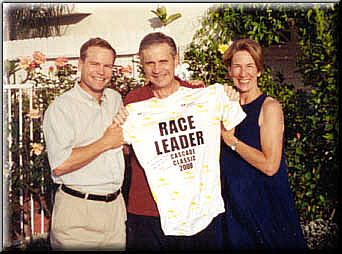
I presented them with the Yellow Jersey from the 2000 Cascade Cycling Classic. 8/4/00
An Update, October 23, 2000
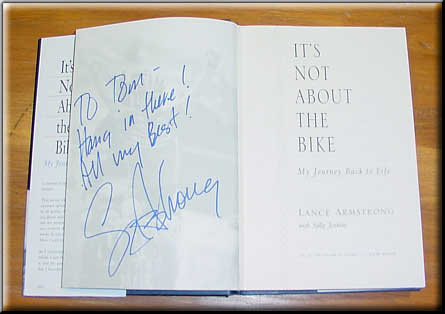
Tom and Sandy are big fans of Lance Armstrong, who survived cancer and came back to
win the Tour de France twice. Lance's book has been a big inspiration to the Hazens.
I recently saw Lance at a book signing event and he offered encouragement to the Hazens.
October 10, 2001
Sandy Hazen and Dr. Robert Cameron are pleased with the progress that MARF has made so far, but understand that much more work needs to be done. Ms. Hazen, who lost her husband Tom to the tumor on December 23, 2000, has contributed $25,000 to the foundation. Dr. Cameron continues to devote his career to improving and extending the lives of mesothelioma patients from around the world.
